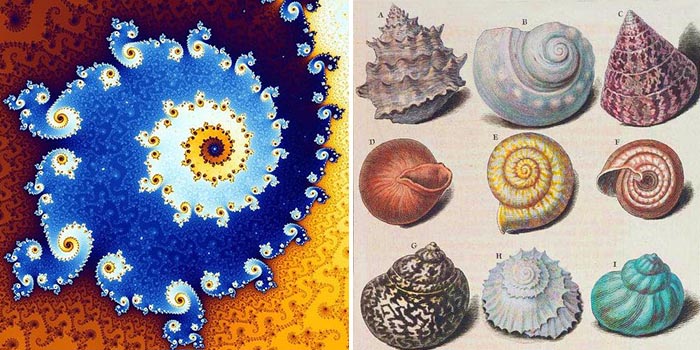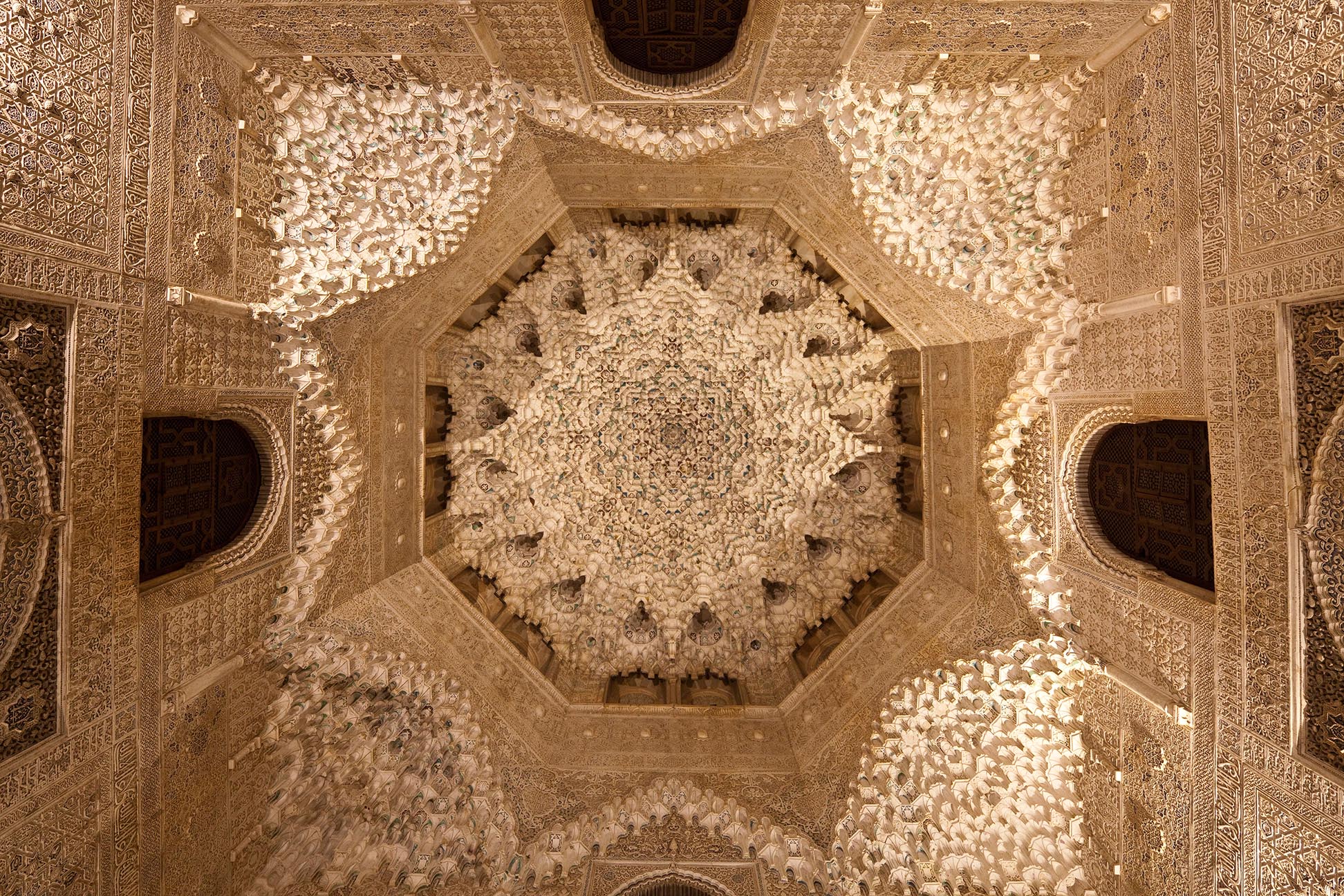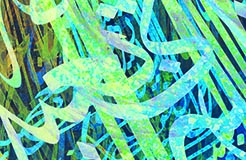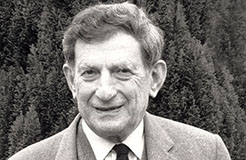A Thing of Beauty… _|_ Issue 26, 2024
A Thing of Beauty: The Mandelbrot Set
Richard Gault explores the meaning of an extraordinary mathematical phenomenon
Play the video (duration 1:45) to witness the infinite unfolding of the Mandelbrot set
Play the video to witness the infinite unfolding of the Mandelbrot set
A Thing of Beauty: The Mandelbrot Set
Richard Gault explores the meaning of an extraordinary mathematical phenomenon
Beauty seems either to be just there in the natural world, waiting to be recognised – think of sunsets – or to be the work of artistic inspiration. But at the end of the last century an astonishingly beautiful mathematical discovery was made – the Mandelbrot set. Nothing quite like the fantastic patterns it generates had ever been seen before 1980. The mesmerising images are made up of intricate fractal shapes – that is, irregular shapes which remain similar though never identical as more detail is revealed. Natural phenomena as diverse as snowflakes, the leaves of ferns and the form of mountain ranges can be described as Mandelbrot fractals. But they can also be seen in human constructs such as the muqarnas in Islamic architecture or in the design of Persian rugs.[1]
The term ‘fractal’ was only coined in 1975 by the man after whom the Mandelbrot set is named, the Polish-French-American mathematician and polymath Benoit Mandelbrot. The story of its discovery, and of Benoit’s role in it, is related by Arthur C. Clarke in the 1995 Netflix documentary Fractals: The Colours of Infinity (see end of article). Clarke remarks during the documentary: ‘I’m often asked, well these pictures are all very pretty but what’s their practical value?’ And it is true that while the Mandelbrot set does have practical applications – in computer graphics, for example – its usefulness is relatively limited. It does not compare with, say, Fleming’s discovery of penicillin or the uses of the laws of electromagnetism developed by Faraday and Maxwell. Or within mathematics itself, the discovery and development of calculus and differential equations which affect each of us daily: almost everything that has been engineered will have been designed using these mathematical techniques.
That Clarke was ‘often asked … what’s their practical value’ is revealing. It shows that practical value is a widely accepted yardstick. This was not always the case. Those who ask the question unwittingly live by the vision of the founding father of modern Western science, the Englishman Francis Bacon. Bacon wrote in 1597: ‘The real test of knowledge is not whether it is true but whether it empowers us.’ This was a radical and novel idea four hundred years ago. Now utility almost overwhelms all other values. But there are other purposes knowledge can serve and I want to suggest that for the Mandelbrot set, there is a very interesting and important philosophical one.

A Philosophical Role
.
A core role of philosophy is to help us find answers to fundamental questions about ourselves and the reality we find ourselves in. Existential and metaphysical questions are also the ones that all the great spiritual traditions address. There are, of course, differences between the way that spiritual seekers search for answers and the methods of philosophers. One of the most essential of these is that most contemporary philosophers accept that there is just one level of reality, which is the reality we know and experience through our senses. By contrast, all spiritual traditions acknowledge at least two levels: the sensory, material world and another deeper, hidden world of spirit and consciousness.
I did not say ‘all contemporary philosophers’ – just ‘most’. It is true that most modern philosophers, as well as virtually all of Bacon’s successor scientists, investigate reality on the understanding that what is real is simply what can be observed and measured. However, there is a significant number who do not. Important examples of such heterodox thinkers in our present day include those whose work we have covered in Beshara Magazine over the last five years: Philip Goff, Iain McGilchrist, Federico Faggin and Bernardo Kastrup. They recognise that there is a higher primordial level of pure consciousness out of which ordinary reality emerges.
I also wrote ‘most contemporary philosophers’ because before the modern age, there were many major philosophers who recognised distinct levels of reality. Plato was particularly famous and influential for arguing that the phenomenal world is merely a shadow of a deeper, truer reality. That reality, he wrote, is the world of forms or archetypes. So, for example, all horses we see are manifestations of the ideal horse form according to Plato. Likewise every beautiful sunset, beautiful rose or beautiful song reveals in its own way the essential idea of beauty. Iain McGilchrist echoes Plato in describing fundamental values such as beauty as ‘ontological primitives’.
A similar understanding is brought out in Islamic philosophy. The 13th century philosopher and mystic Ibn ‘Arabi also used the analogy of shadows, maintaining that what we see in the world is really a projection – as in a shadow theatre – of events in this other, vertical dimension. This hidden reality, as Eric Winkel explained in our conversation with him last year (click here) is the domain of the ‘Divine Names’, and thus the external world is understood to be an arena where the Divine Names play out.
Interesting as the ideas of Ibn ‘Arabi and Plato are, how easy is it to accept them? Is it really plausible that what we see – this complex, rich, ever-changing world – could actually be the product of relatively few, unchanging forms or names? I argue that the Mandelbrot set provides an answer, or at least a way of opening ourselves to the answer, as it vividly demonstrates how an endless variety can emerge from something that is in itself quite simple.

How a Simple Equation Generates Unique Complexity
.
This is because the astonishing patterns of the set are generated by a remarkably concise mathematical equation:
Z = Z2 + C
How such a simple formula can give rise to such intricate and exquisite patterns is explained in some detail, but in an easily understood way for the non-mathematician, in the video right or below.
Video: The Mandelbrot Set Explained. Duration: 25:59
I try to outline it myself here…
The Mathematics behind the Mandelbrot Set (click to open)
The equation
Z = Z2 + C
is an iterative equation which generates a series of numbers. It says that each successive number is simply the square of the previous one plus a constant C. The sequence begins by setting Z to zero, so that the next Z has the value C (i.e. 02 + C). The following Z will be C2 + C, and so on.
The complication is that the numbers in this equation are not the ordinary numbers everyone is familiar with. The Zs and C are ‘complex numbers’ which can be represented not as a point on a line or linear scale but as one on a two-dimensional graph. Though most of us do not think of numbers in this way, mathematicians do and have no trouble working with them. Just as with ordinary numbers the usual rules of arithmetic – like addition and multiplication – work for complex numbers.
It is apparent that the series of numbers this simple equation generates depend on the choice of C. If we were working with ordinary numbers, for most Cs the Zs will get bigger and bigger. For example, if we begin with C = 1, the first Z will simply be 1, the second 12 + 1 = 2, the third 22 + 1 = 5, the fourth 26, etc. The sixth Z is already very big at 45,8330. However, there is a small range of values of C which result in the Zs being confined or bounded within a narrow limit. Starting with a value between negative 2 and positive 0.25, the successive values of Z will be trapped between -2 and +2.
The same thing happens with complex numbers. Depending on where the first point on the graph is (i.e. C), the Zs either shoot off to infinity or become bounded. The beautiful patterns generated by the simple iterative equation simply show where numbers (the initial point, C) will get bigger or become bounded as it generates successive numbers. Numbers represented by a point on or within the black shapes will get trapped within them (this set of numbers is the Mandelbrot set). Points outside the black shapes will get bigger.
What of the colours? Surely Z and C are colourless? The colours are indeed artificial. They are used in a way analogous to how colours can be used on maps to represent different heights. Here the colours represent how rapidly numbers outside the black shapes will accelerate toward infinity. Clearly this too depends on the starting point. To illustrate using just ordinary numbers: if we choose the first point, C, to be 1, then the third point in the sequence will be 5, But if we start with 5, then the first number will be 30 and the third 905. So the acceleration to infinity is far faster if we begin with 5 rather than 1.
Measuring the speed with which the Zs expand and then attaching a colour to them is easy in theory, but in practice it is only possible with a computer, as the patterns we witness require the generation of many hundreds of numbers (or points) every second. The discovery of the Mandelbrot set required the invention of the computer so that it could be said: yes, a computer is useful but it can yield beauty.
… but understanding the mathematical intricacies of how the magic happens is not really important for grasping the main point I want to make, which is that a simple equation, once brought to life, can yield enthralling, ever-changing intricacy and beauty. Each feature of a Mandelbrot pattern, while similar to others, is unique, despite there being an infinite number of them and them all being the product of the same, simple equation. Thus we can see that it is possible that while there is only one ideal, Platonic horse, the countless horses we see in the world are all different and unique; and that while there is just one Name for Beauty, there are endless manifestations of beautiful sunsets, roses, songs.
The Mandelbrot set does not prove that thinkers such as Plato, Ibn ‘Arabi and McGilchrist are right, of course. But it does offer an analogy to help us understand what they are suggesting. To believe something it is necessary to first accept that it is believable. In our secular, scientistic age, the step of acknowledging that reality might not be confined to the observable is difficult, often unsurmountable, for many people. Therefore the infinite generative capacity of the Mandelbrot set can be useful as a way of opening minds and hearts to another, I believe much richer, way of understanding the world.
Further: not only does it suggest why the idea of different levels of reality is believable, it also gives an answer to the question that might arise; why, if Plato is right, did reality not stop at the level of the ideal? Look again at the Mandelbrot equation, Z = Z2 + C. There is an elegance here and, perhaps for a mathematician, it has a certain beauty and perfection in itself. But its true magnificence is a hidden one, in that it is essentially a potential. The beauty within it is invisible and can only be seen when it is brought out by letting a computer unfold the equation. In the same way, Plato’s ideal horse is fine in itself, but it wants fulfilment in, among others, the chestnut stallion I see grazing in the pasture close to where I live. Ideal forms, as well as Ibn ‘Arabi’s and McGilchrist’s ontological primitives, appear in a very real sense to need to express themselves.

The Dome, Hall of the Two Sisters, Court of the Lions, Alhambra, Granada, where according to Nurfan Tercan [/] the arrangement of the muqarnas is based upon fractal geometry. Image: B.O’Kane [/] / Alamy Stock Photo
Move your computer mouse over the image to enlarge
What Science Is and Is Not
.
The Mandelbrot set also helps us to understand what science is. Confronted by the rich complexity of the world as it presents itself, scientists attempt to describe how it works in relatively simple terms. They seek the rules or laws which underlie the behaviour of everything from photons to galaxies. This is not easy. Their task is analogous to being presented with a set of Mandelbrot images and being challenged to discover the equation that produced them. It would be extremely difficult, if it is possible at all, to derive the source equation, Z = Z2 + C, by interrogating the patterns. How much more challenging, then, is the task that science has set itself? So it is right that philosophers of science acknowledge that scientific theories cannot claim to be true, but are just the best explanation found so far for a particular phenomenon. That science offers only provisional approximations maybe should be better known by the general public – and indeed by many practising scientists.
It can also be noted that usually the rules or models that scientists propose are not iterative like the Mandelbrot set. They are static equations, like Einstein’s E = MC2 and linear models like Newton’s laws of motion. By contrast, Mandelbrot’s equation is itself a process in motion. As such it is in keeping with the ancient idea, first expressed by Heraclitus and echoed in our own times by McGilchrist, that reality should be understood to be ‘based on process and flow’ rather than on concrete, static matter. Here again, the set provides an analogy which may assist people to comprehend new ideas.
Bacon sparked a revolution in the 16th century that has culminated in the commonly accepted way of seeing the world. The Mandelbrot set with its marvellous patterns may help people accept that there can be a different way of understanding reality. The time may yet come when, amongst other things, a scientific discovery is greeted with – yes it could be useful but would it really be beautiful?
Video: Fractals: The Colours of Infinity. Duration: 53:44

Dr Richard Gault gained a Ph.D from Strathclyde University in Scotland. Now retired, his career spanned teaching and research in universities in Scotland, Ireland, Germany and the Netherlands. His interests came to focus on the history and philosophy of science and technology. He has had a long association with Beshara and the Chisholme Institute where he served as principal from 2015–17. He currently lives with his Dutch wife in Harderwijk in the Netherlands.
Other Sources (click to open)
[1] NURFUR TERAN, Fractal Dimension and Perception of Order in Islamic Art. DOI: http://dx.doi.org/10.5772/intechopen.109432
FOLLOW AND LIKE US
——————————————
——————————————
——————————————
Video: The Mandelbrot Set Explained. Duration: 25:59
FOLLOW AND LIKE US
If you enjoyed reading this article
Please leave a comment below.
Please also consider making a donation to support the work of Beshara Magazine. The magazine relies entirely on voluntary support. Donations received through this website go towards editorial expenses, eg. image rights, travel expenses, and website maintenance and development costs.
READ MORE IN BESHARA MAGAZINE
Bringing Light to the World: the Vision of Ibn ‘Arabi
Dr Eric Winkel talks with Jane Clark and Richard Gault about what the wisdom of the great 13th-century philosopher / mystic can offer us in these troubled times
Faces of the Infinite
Stefan Sperl talks about about his project on Neoplatonism and the poetic traditions of Europe and the Near East
The Matter with Things
Dr Iain McGilchrist discusses his most recent book which brings together neuroscience, psychology and philosophy into a unified vision
Wholeness, Timelessness and Unfolding Meaning
An interview from the archives with physicist and philosopher David Bohm
READERS’ COMMENTS




I just discovered this wonderful magazine with the video of the Mandelbrot Set. Now I’m a subscriber.
Valid and useful article, but the idea doesn’t really require consciousness or spirit. See Max Tegmark’s “mathematical universe hypothesis”. A metaphysics of platonic mathematical monism.
Excellent article.
The Mandelbrot Set provides a useful illustration of the way I understand nonphysical reality. Thinking of Mandelbrot space as a physical analog of a conceptual singularity helps me imagine how my mind navigates etheric space. For instance, we can navigate our mental space by changing our basic assumptions which is “C” in the Mandelbrot Set equation.
Consider https://ethericstudies.org/cosmology-imaginary-space/